
It’s Summer in San Francisco, and that means soup weather. And what goes better with soup than a nice tender, wheaty dinner roll with whole grains and seeds? I’d never made such a bread, but why not try?
I’ve never really invented a formula before, just tried adaptations of proven formulas. But I didn’t find a formula that looked quite like what I was after: something in between the Hamelman Whole Wheat Multigrain and an enriched whole wheat-oatmeal bread. So I looked to my experience with enriched whole wheat and oatmeal breads, read a number of TFL entries about how to achieve a soft crust and about seedy breads. Then I looked at a bunch of formulas from Hamelman and Reinhart, and put pencil to paper (with calculator at hand).
Since I had a very active starter going, I decided to make a leavened dough, with a pinch of instant yeast.
I also had in mind trying the Central Milling Organic Type 85 flour for something besides a Miche. So that’s the flour I used for this experiment (but I think a mix of 50% whole wheat and 50% bread flour would work fine).
I mixed the levain last night, and this morning I soaked some Bob’s Red Mill whole grain cereal (Five Grain with Flax seed) and toasted some wheat germ and some pumpkin, sunflower and sesame seeds.

My calculation on paper of the proper hydration for this dough was a ways off, presumably due to the thirsty whole grains, and I ended up having to add more water during the initial mix. Reminded me of proth5’s discussion of the “hydration neutral” concept.
But once I got the dough texture feeling right (kind of like the Hamelman Oatmeal bread), it was a joy to handle. Having no clear idea how long the bulk ferment should be for this dough, I just watched the dough, not the clock (hmmm…where have I heard that before). After about 1 ¾ hours, the dough had expanded about 50% and seemed nice and airy.

So that’s when I divided and pre-shaped the dough into 3 oz balls, waited 30 minutes, and then shaped the balls into round rolls.
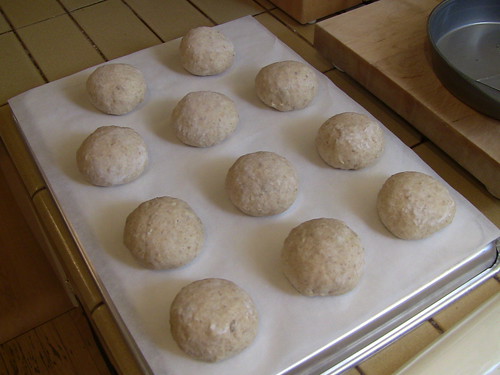
They proofed 1 ¼ hours, then baked for 18 minutes, the first half with steam.
They came out a nice golden brown, and they make the house smell delicious.
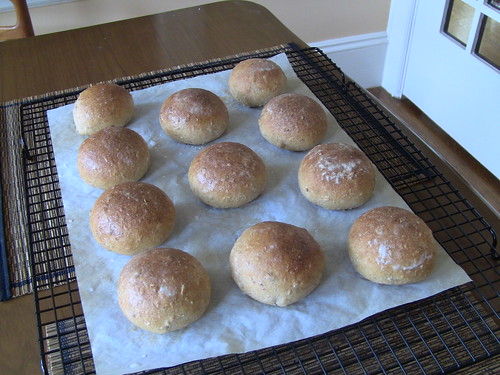
I let them cool about 40 minutes before I couldn’t resist any longer. They are about the density of a firm whole wheat bread; nice and springy, but firm; the structure would be good for a sandwich loaf. The seeds and whole grains make for a nice mix of feel and flavor.
The flavor is nutty and complex, just the slightest bit sweet. It would be excellent with a sharp cheese or with peanut butter, or just sweet butter. My wife enjoyed the first taste a lot, and said it would be great with raisins added…and nuts and cinnamon (she has a thing for cinnamon-fruit-nut breads). That’s a variation I’ll try.
All in all, a good experiment. The formula follows a few more photos.
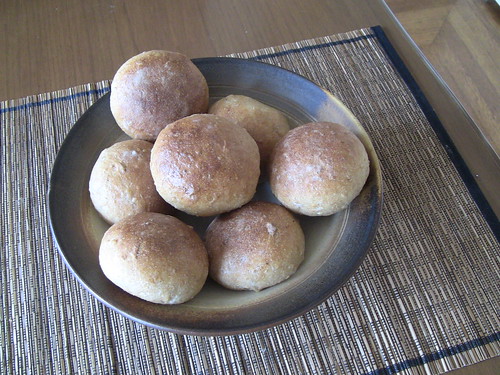
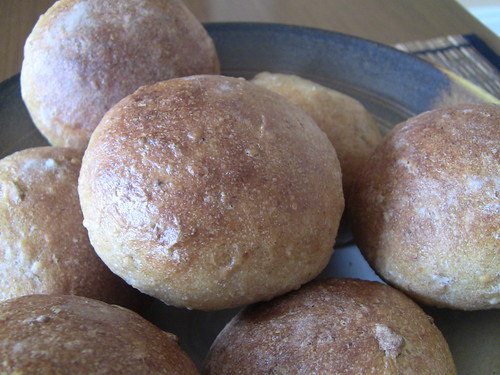
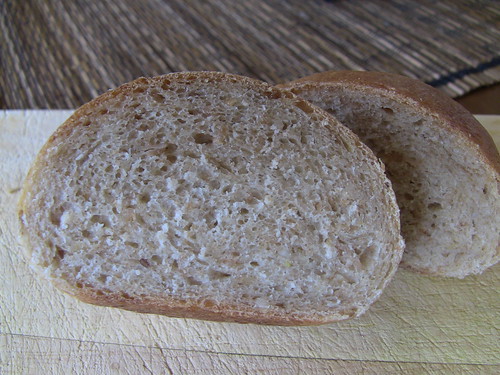
Multi-grain Seedy Rolls
(7/31/11)
Liquid Levain
.4 oz ripe starter
2.4 oz water
1.9 oz Type 85 flour
Soaker
2 oz BRM 5-grain cereal mix
2.5 oz hot water
Final Dough
14.1 oz Type 85 flour
.4 oz baker’s milk powder
.05 oz instant yeast
6.8 oz warm water
.7 oz honey
.8 oz vegetable oil
liquid levain (all)
soaker (all)
.35 oz salt
1.2 oz toasted seeds (mix of sesame, pumpkin and sunflower) and wheat germ
Procedure
1. The night before baking, mix the liquid levain and leave covered at room temperature 10-14 hours.
2. An hour before mixing dough, (a) toast seeds and wheat germ in 300 F oven for 40 minutes, then let cool, and (b) pour hot water over cereal for soaker, and cover bowl.
3. Mix flour, milk powder and instant yeast.
4. Mix water, liquid levain, honey, vegetable oil, then add soaker.
5. Pour dry ingredients into liquid ingredients and mix to shaggy mass.
6. Cover for 30 minute autolyse.
7. Add salt and toasted seeds and wheat germ, and mix thoroughly, then knead five minutes to medium development.
8. Bulk ferment at 70 F. for two hours with four way stretch-and-folds at 45 minutes and 90 minutes.
9. Divide into approx. 3 oz pieces and pre-shape in balls. Rest 30 minutes.
10. Shape as round rolls, place on parchment, and proof one hour.
11. Pre-heat oven, with baking stone and steam apparatus, to 450 F.
12. Transfer parchment to baking stone and bake 9 minutes with steam, then remove steam apparatus and lower temperature to 400 F. Bake an additional 9 minutes or so (to internal temperature of 195-200 F), rotating the parchment for even browning as necessary.
13. Remove rolls from oven, and brush with milk (if you like softer crust). Cool on rack for 30 minutes or more.
Submitted to Yeastspotting (http://www.wildyeastblog.com/category/yeastspotting/)
Glenn























